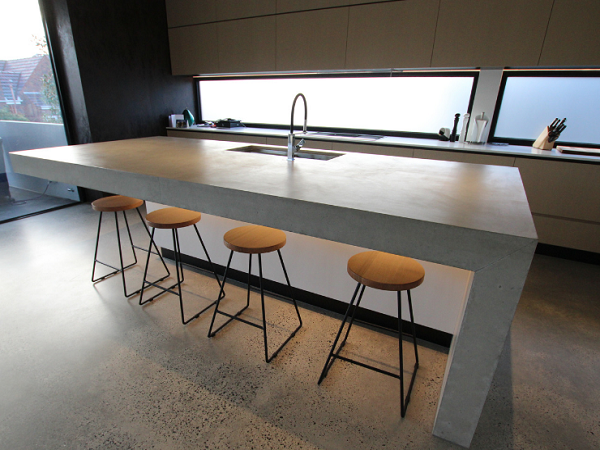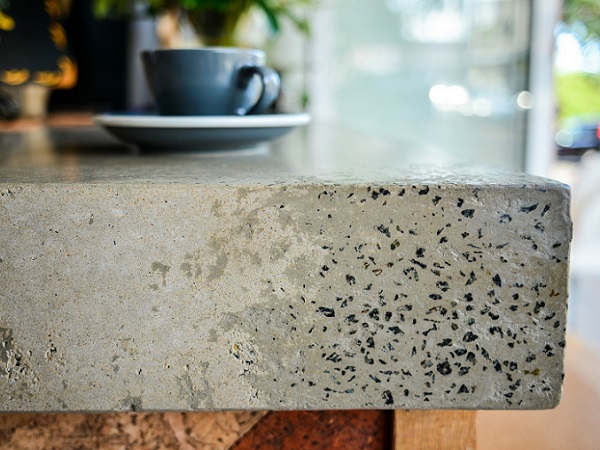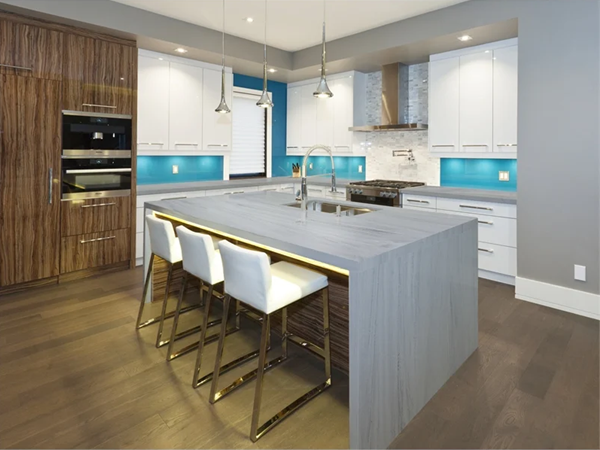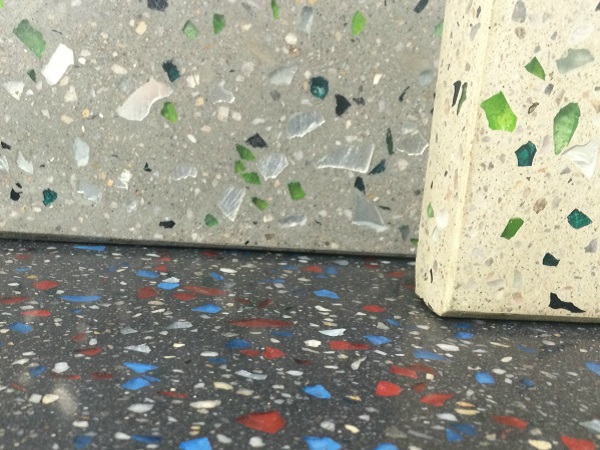Until 15 or 20 years ago concrete benchtops were virtually unheard of, particularly as interior surfaces. However, the introduction of new techniques, tools and sealants has changed all that. Concrete benchtops are now a real option, not just for exterior use but also in kitchens, laundries, and bathrooms.
Designers have come to understand that the tendency to dismiss concrete as too ‘raw’ or ‘masculine’ for such applications is unfounded. Concrete doesn’t begin and end with Brutalism. Indeed, if combined with the right aesthetic choices, concrete countertops can provide as much warmth as any material.
Concrete countertops are ideal for kitchens with an industrial look. However, considering the rich patina that the material develops over time, they are just as capable of providing a rustic feel.
Pros and cons of concrete benchtops
Concrete benchtops have many benefits. Durable and hardwearing, they are also incredibly versatile. Considering how they are made – poured in situ or pre-cast – they can be customised into virtually any shape or size.
However, it must be remembered that concrete is made of the same cement, quikrete, and sand mix as footpaths and therefore is heavy. In cases where the building in question has a stump floor, engineered supports may be needed to handle this extra weight. And, depending on its thickness, supports may also be required to prevent damage to adjoining cabinets.
Concrete countertops also have a tendency to crack. However, these are usually superficial and easy to repair. Their surface can scratch and chip more than alternatives and, because they are porous, they can even allow bacterial growth. The good news is that all these problems can be minimised by proper care and the use of quality sealants.
Types and Colours of concrete benchtops
The biggest advantage of a concrete bench top compared to alternatives like granite and marble is their versatility. They can be customised to suit the wishes of designer or homeowner. They can be made to mimic the appearance of those two alternatives just mentioned or to accentuate the natural properties of concrete.
Alternatively, some choose to add aggregate materials to concrete countertops for a textured look or even to mimic quartz or granite. When it comes to aggregate materials, the choices are limited only by the imagination. They can include seashells, scrap metal, and even phosphorescent, glow-in-the-dark materials.
This versatility extends to the thickness of polished concrete benchtops; the addition of drain boards or trivets, and splashbacks; customised edges and more. Similarly, there are many colour choices. Using dyes and other colouring agents, anything from white concrete to near black is possible.
How to maintain concrete benchtops
To protect a polished concrete bench top from chips, scratches, stains, and heat damage, it is important to apply sealers to them, not just at the time of installation but every one to three years. There are various types of sealers available, including topical sealers and penetrating sealers.
Applied only to the outer surface, topical sealers are intended to protect the concrete by covering it and therefore not allowing any damaging material harm it. They rate well in terms of stain resistance but are less effective when it comes to scratch resistance.
Penetrating sealers can be divided into two categories, densifiers, and repellents. As their name suggests, penetrating sealers penetrate the surface, close the pours of the concrete, and strengthen the material. Unlike topical sealers their strength lies in scratch resistance.
Alternatively, it is possible to use both types of sealers on the same concrete countertops. Nevertheless, despite the fact their quality has improve significantly in recent years, no sealers are 100 per cent effective. Stains, heat damage, scratches and chips are always a possibility.
The best way to minimise them is to simply take good care of the concrete kitchen bench. Clean it as soon as spills occur, never place hot plates or oven dishes directly onto it and only ever use knives on cutting boards (never directly on the concrete bench top).
Those installing polished concrete benchtops need to be aware that polished and coloured surfaces can be affected by temperature extremes and sunlight. As such, they should use UV resistant sealers.
How much do concrete benchtops cost
When evaluating the cost of concrete benchtops in comparison to alternatives, it is important to factor in the costs of customisation, labour, and installation. While the cost of concrete itself is relatively low, the addition of these other factors significantly increases overall costs.
Therefore, while polished concrete benchtops installed in standard layout and left in their natural colour are affordable, customised, personalised countertops can be expensive.
To generalise, concrete countertops are a lot more expensive than laminate alternatives, but only a little more expensive than engineered stone benchtops. On the other hand, they are generally more affordable than natural stone materials such as granite or marble. Concrete countertops made and installed by professionals cost about $1,000 - $1,800 for the whole kitchen.
DIY concrete benchtop Australia
Is a DIY concrete benchtop an option? Installation of polished concrete benchtops is a complex job, involving heavy materials, as well as precise mixing, finishing, and curing processes. For this reason, DIY installation of concrete countertops is not recommended for anyone but the most enthusiastic and experienced. Not recommended for the average person from Sydney or Melbourne.
For those willing to take on this difficult job, the procedure is as follows:
How to make concrete benchtops, How to polish concrete benchtops
1. Make the mould
2. Make any cut-outs
3. Add sides to the mould
4. Build a support frame and prep the wire
5. Mix and pour concrete
6. Remove the mould
7. Finish the slab using an orbital sander
8. Install the concrete bench top
Types of concrete benchtops
1) Polished concrete benchtops
A sleek, polished concrete benchtop in a stunning minimalist kitchen.

2) Aggregate concrete benchtops with a textured look
Here the addition of dark aggregate materials is used to provide a look of textured natural stone. When it comes to aggregate materials, the choices are limited only by the imagination.

3) Concrete look benchtops
‘Think Benchtops 3600 x 600 x 20mm Vena Storm Solid Surface Modular Benchtop’
Non-porous and easy to clean, these modular concrete look benchtops deliver the appeal of polished concrete without the expense. Available from Bunnings, they are suitable for DIY installation and are available in a range of sizes.

4) GFRC concrete benchtops
‘Apollo Place Concrete Island’
Similar to chopped fibreglass, Glass Fibre Reinforced Concrete (GFRC) is made by mixing fine sand, cement, polymer, water, other admixtures and alkali-resistant (AR) glass fibres. The material displays high compressive, flexural, and tensile strength and offers similar levels of chip resistance as granite.

5) Aggregate Concrete Benchtops
Proof positive that brutalism isn’t the only option when it comes to concrete, aggregate materials can include everything from clear mirror glass to coloured glass pieces and glow in the dark stones on backgrounds of any tone.

6) Extra thick GFRC concrete benchtops
Glass Fibre Reinforced Concrete (GFRC) makes it possible to customise benchtop thickness. The example pictured is 75mm thick and features a satin matte finish. In this example, aggregate materials are kept to a minimum and the result is light and playful.


